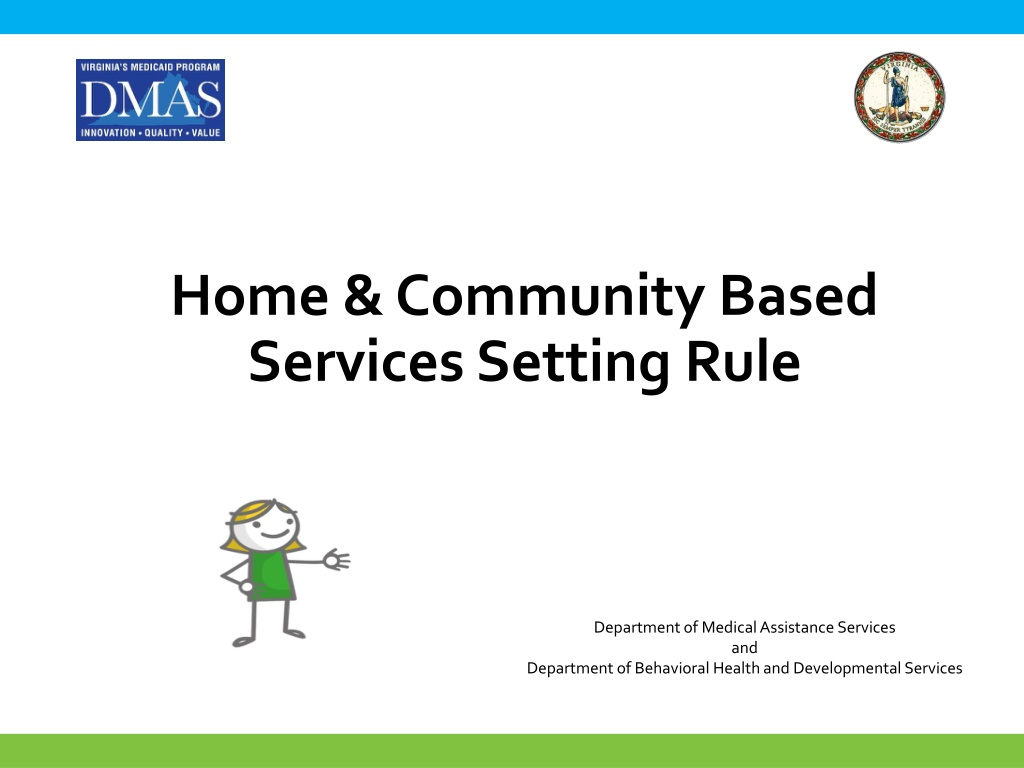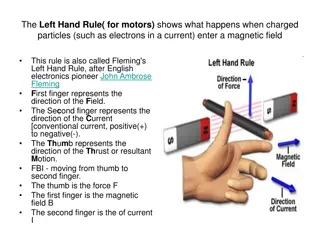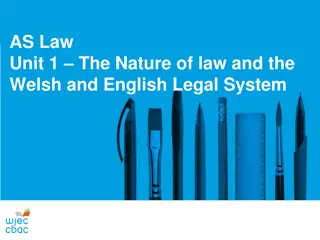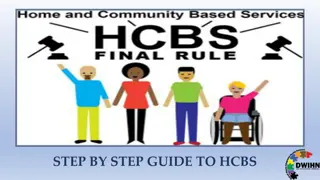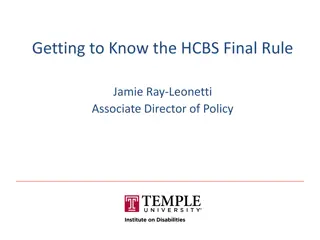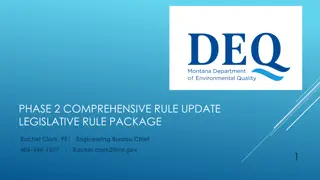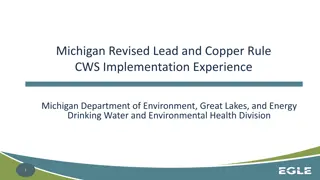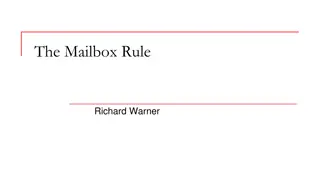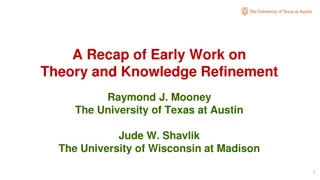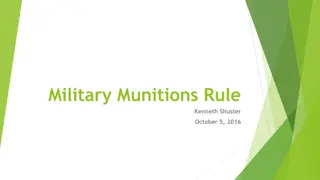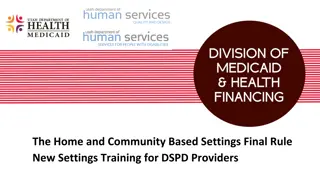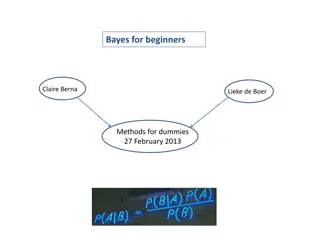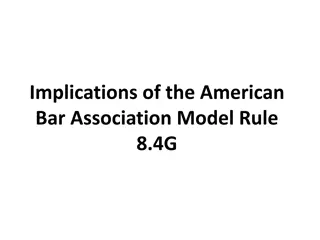Home & Community Based Services Setting Rule Overview
This piece provides comprehensive information on the Home & Community Based Services (HCBS) setting rule, emphasizing the importance of residential protections and individual rights for Medicaid recipients. It covers key aspects such as the purpose, goals, regulations, and values associated with HCBS settings. The content also highlights the principles of integration, support for autonomy, and presumed competence in serving individuals with disabilities.
Download Presentation

Please find below an Image/Link to download the presentation.
The content on the website is provided AS IS for your information and personal use only. It may not be sold, licensed, or shared on other websites without obtaining consent from the author.If you encounter any issues during the download, it is possible that the publisher has removed the file from their server.
You are allowed to download the files provided on this website for personal or commercial use, subject to the condition that they are used lawfully. All files are the property of their respective owners.
The content on the website is provided AS IS for your information and personal use only. It may not be sold, licensed, or shared on other websites without obtaining consent from the author.
E N D
Presentation Transcript
Home & Community Based Services Setting Rule Department of Medical Assistance Services and Department of Behavioral Health and Developmental Services
Housekeeping Tips Microphones are muted because of the size of the training. Enter all questions into the Q&A document. Q&A document will be posted to the toolkit. Any questions we are unable to answer will be included in the Q&A document. This training is being recorded.
Purpose The purpose of this training is t0 discuss the specific residential protections that are outlined in the HCBS Final Rule. Providers of sponsored residential, group home and supported living are required to fully comply with all HCBS requirements. 3
The Goal Individuals receiving Medicaid home and community based services must have every opportunity to live with the same rights, freedoms, and degree of self-determination, and have the opportunity to integrate within their community, as anyone not receiving Medicaid home and community based services. HCBS members must have the opportunity to live as freely and independently as you and me. 4
Home and Community Based Services The Home and Community-Based Services (HCBS) settings regulations (previously known as the Final Rule ) was published in the Federal Register on 1/16/14, and became effective on 3/17/14. States have until 3/17/23 to come into compliance. 5
Setting is integrated & Supports Full Access to the Community Rights of Privacy Dignity, Respect & Freedom from Coercion & Restraint Values, Principles, Common Language HCBS Requirements Optimize, but does not regiment individual initiative & autonomy Additional Conditions for Residential Settings Facilitates choice regarding services and supports and who provides them 6
Presumed Competence Presumed competence is a strengths-based approach that assumes people with disabilities have the ability to learn, think and understand. This includes the ability to make choices (maybe even choices that their supports, natural and paid, disagree with), determine their own goals and be the person in charge of their life path. 7
HCBS Setting Basics: Be integrated and support access to the greater community; Provide opportunities to seek employment and work in competitive integrated settings; Facilitate individual choice regarding services & supports and who provides them; Ensure an individual s rights of privacy, dignity, respect, and freedom from coercion and restraint; Be selected by the individual from among setting options, including non-disability specific settings; Participate in the person-centered planning process. 8
Additional Rights in HCBS Residential Locations: Individuals should have a lease or other legally enforceable agreement; Privacy in room with lockable doors; Choice of roommates; Freedom to furnish and decorate the unit; Freedom and support to control schedules and activities; Access to food any time; Right to have visitors at any time; Have an accessible environment. 9
Lease/ Residency Agreement Individuals should have a lease or other legally enforceable agreement. Follow the VA Landlord Tenant Act. Address eviction procedures. Not be in conflict with HCBS agency policies. Virginia Department of Housing and Community Development 10
Privacy and Locks Privacy in room and lockable doors. Doors should have locks with keys, but key pad locks are acceptable if an individual is able to use a key pad lock. Staff and other individuals knock before entering AND wait for permission to access. Doors can be closed when the individual is in their room. An individual can use the phone, computer, etc. in the privacy of their room with the door closed. 11
Bedrooms If a room is shared, the individuals must choose with whom they share the room. Freedom to furnish and decorate the unit. Examples include: bedroom paint color, bedspreads, d cor, pictures, furniture, TVs, technology, etc. 12
Bedrooms The individual should be asked for their preference in decorating the room. If the individual shows no specific interest in decorations, then the residential provider should strive to decorate the individual s room in a manner that fits the individual s personality/interests and not only the interests or preferences of the provider, family, etc. 13
Schedules Individuals should be able to wake up and sleep when they want. Choose to stay home or go on outings. Have the option to use public transportation instead of the van. Participate in preferred activities in and out of the home. Freedom and support to control schedules and activities. 14
Access to Food Have access to food at any time. Eat what, when they want and where they want. Individuals should have the choice to eat earlier or later than established meal times, and have a snack when they want. 15
Visitors Right to have visitors at any time. Ability to have overnight visitors. Visitors are not limited to family. Visitors can be friends, co-workers, and significant others. Visitors do not need to be pre- screened. 16
Access Have a key to the entrance door of your home. Right to an accessible home. Ability to access all common areas, bedroom and bathroom. Accessible entrances and exits of the home. As a reminder, the right to an accessible environment CAN NOT be modified! 17
Modifications As a provider, you were required to have included a specific modification section in your HCBS policy. You are responsible for following your own policy. Ongoing staff training on modifications and the HCBS policy will improve consistency in all settings owned or operated by the provider. The modification process does not negate any required Human Rights process. Please reach out to your local Human Rights advocate if you have questions regarding the Human Rights regulations. 18
Modifications When all options for less restrictive interventions have been tried without success to support an individual s health and safety needs, a provider can implement a modification of a residential specific right. The process for implementing rights modifications is person-centered. It ensures that the individual fully understands and agrees to the modifications. 19
Modifications To determine if a modification is necessary, ask the following questions: Are any of the residential specific protections causing a health and safety concern for the individual receiving services? Have less intrusive interventions been used? This could include: specific staff supports, natural supports, specific services (AT, TC, etc.). Will the proposed modification do no harm to the individual? Does the individual/guardian/authorized representative consent to a modification? 1. 2. 3. 4. 20
Modifications If a modification is required, it is not expected to remain in place forever. A provider is required to collect data on the intervention and review the modification on an ongoing basis. Data collection and review must measure the ongoing effectiveness of a modification. Modifications must be reviewed at time limits that are established by the provider (ex- monthly, quarterly, etc.). At this review, the ability to terminate the modification must be discussed. 21
Modifications The modification must be documented in the Safety Restriction Form located in WaMS. This is included in the provider ISP section. The modification process does not negate any required Human Rights process. Please reach out to your local Human Rights advocate if you have questions regarding the Human Rights regulations. 22
Marys Story Mary has a history of eating non-food items. When staff offered Mary a key, she attempted to eat it. Staff discussed the idea of a key pad entrance, but Mary s motor skills are a barrier to this option. As such, Mary s right to access her bedroom key has been modified. The staff will keep Mary s key in a closet. She can inform staff when she would like to lock her door. Mary consented to this modification, it is documented in her ISP, and the provider follows the process to review the modification from time to time. 23
Marys Story Mary s attempt to eat a key is a health and safety concern. Staff looked into less restrictive options (key pad) and documented it. Mary consented to this modification. Staff documented appropriately, has data collection elements included in her plan and will review the need for the modification quarterly when completing her person- centered reviews. 24
Justins Story Justin spends a great deal of time on social media and dating apps. He has made connections with many people online and has been taken advantage of in financial schemes and catfishing. Justin has recently made several connections to people online and he invited these folks to his house (group home setting). Justin did not know these people and provided them with an invitation to come in the home as well as his address & phone number. Strangers have shown up at Justin s home. Staff discussed with Justin the safety risks of his choices and explained boundaries with strangers. 25
Justins Story Justin s mother also discussed safety awareness with him and encouraged him to meet people in public places. Justin did agree that meeting people in public places (coffee shops, parks, restaurants, etc.) would be a safer option rather than inviting people to his home. However, he said he feels pressure to make his online friends happy. Justin and his support team decided that Justin s right to have visitors at any time requires a modification until additional safety awareness skills are acquired. 26
Justins Story Justin s internet behavior causes a safety concern. Natural and paid supports have provided education and supports to Justin to address the unsafe behavior. Justin consents to the modification. Justin is not fully restricted from meeting his new internet friends, he will have the option to meet in safer, public settings. Staff will provide ongoing supports to Justin to learn how to have safe online behavior. This is included in Justin s plan and the modification will be reviewed quarterly. The Safety Restriction Form is completed. 27
Amelias Story Amelia is a woman who lives in a sponsored residential setting. She has a diagnosis of Prader-Willi Syndrome and has been recently diagnosed with diabetes and high blood pressure. Amelia frequently tells her sponsor provider that she feels tired and gets headaches often. Amelia s health is greatly impacted by her Prader-Willi Syndrome, but she reports being unable to stop eating because she is always hungry. Amelia and her support team decided to try keeping only diabetic-friendly snacks available, but Amelia continued to overeat and have negative side-effects (like headaches/ increased blood sugar). 28
Amelias Story Amelia s sponsor supported her to seek guidance from her doctor and a dietitian, but Amelia reported that she will not be able to follow their diet plans. As a last resort, Amelia and her team have decided to limit access to the pantry by using a lock and with this plan in place Amelia will be better able to control her diet. Amelia was involved in this decision and agreed to the modification. Amelia s provider also consulted with DBHDS Human Rights prior to installing the lock. 29
Amelias Story Amelia s access to food is causing a health risk. Amelia s provider tried less-restrictive options before implementing a modification. Amelia consented to the modification. The provider contacted DBHDS Human Rights. Provider documented appropriately. 30
What is NOT a Modification? Eric works at Target and his shift begins at 9am. In order to make it to work on time Eric must wake up at 7:30am. Eric does set an alarm on his phone, but he often sleeps through it. Eric has asked his residential staff to support him by waking him up no later than 7:40am if he sleeps through his alarm. This is NOT a modification to Eric s ability to direct his own schedule. This is a requested support that is outlined in his part V and implemented by his support team. Jordan is prone to losing his front door key. As a result, Jordan s sponsored provider keeps the front door key in a lock box outside of the garage. Jordan knows the code for the lock box and is able to access the key whenever needed. This is NOT a modification to Jordan s ability to access the key to his home. He has access to the key and feels satisfied with the current set-up. 31
What is NOT a Modification? Tristan is an individual who resides in a sponsored setting. He has limited motor skills and requires full staff support with all ADL needs. His part V outlines his support needs and gives staff specific instruction for how to best provide him privacy. Tristan is left alone while using the toilet and knocks on the wall when he is ready for staff to support him. This system provides Tristan with privacy and dignity. This is NOT a modification to his right to privacy. It is simply the level of support needed to complete the ADL tasks. Rashan likes to live in a minimal environment. He does not like bright colors, items on his walls or any table top decorations. Rashan s only d cor request is black-out curtains in his room. Rashan s support team did notice that he seems to like the color blue and selected a blue comforter and pillow cases. Rashan s room is minimal, but this is NOT a modification. This is his preference and does not require a modification. 32
Modification Summary A modification should not be used because the provider believes that the individual is incapable of exercising his/her/their HCBS rights. HCBS rights are inherent Human Rights. A modification is not to be used to restrict people from doing things the provider is uncomfortable with. A modification is only to be used for health and safety reasons. A modification must follow the process outlined in the settings regulation (modifications are justified and documented, with alternatives, consent given, and revisited regularly by the provider.) As providers, we are there to support individuals and help them to build skills. 33
Full Compliance Once a setting has achieved full compliance, a letter will be sent to the provider. Reaching HCBS compliance is not a one-time achievement. A provider must maintain their compliance status which will be monitored on an ongoing basis through: The DBHDS Office of Licensing The Office of Human Rights DMAS QMR Support Coordination and other quality monitoring reviews. If a setting can t reach full compliance, the provider participation agreement will be reviewed. Possible consequences include suspension of billing, and removal of the agreement. 34
HCBS Resources Statewide Waiver Transition Plan for review: http://www.dmas.virginia.gov/Content_pg s/HCBS.aspx 35
HCBS Resources The Toolkit can be located on the DMAS Website: https://www.dmas.virginia.gov/for- providers/long-term-care/waivers/home-and- community-based-services-toolkit/ 36
DBHDS Office of Human Rights You can contact the Office of Human Rights Human Rights Contact 37
HCBS Resource You may also reach out directly to DMAS hcbscomments@dmas.virginia.gov 38
